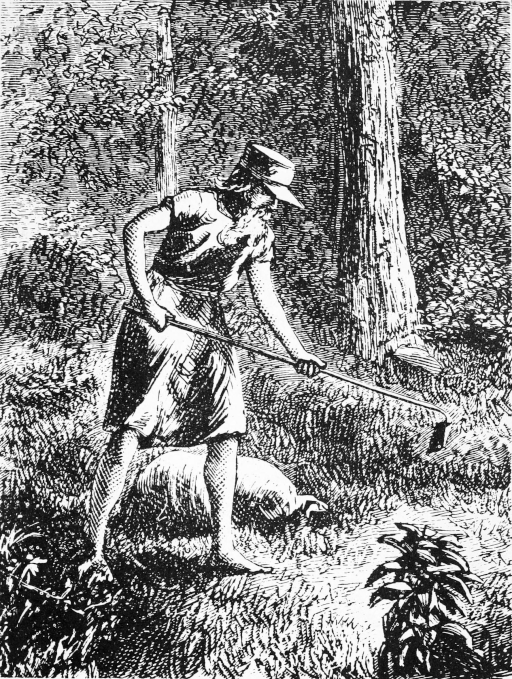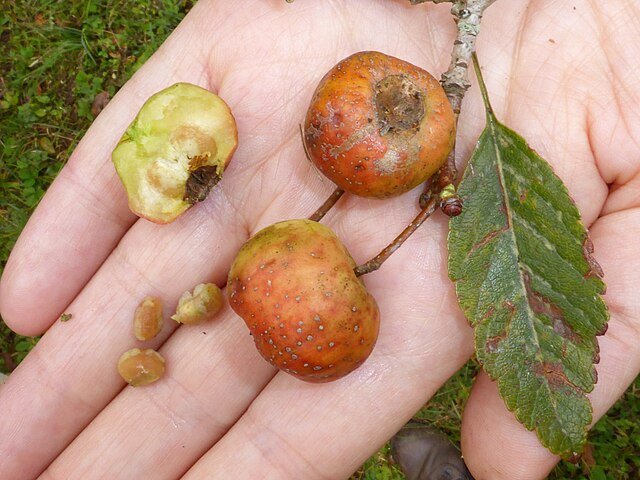The Apple Blossom
The history of the Apple Blossom, how a quaker disrupted the produce market, and why peddling hooch saved a nation.
Malus domestica, April 16
“It is remarkable how closely the history of the apple tree is connected with that of man.”
His real name was John Chapman and he was headed for a life of ignorable obscurity venturing west with his half brother Nathaniel from their birthplace in Leominster Massachusetts, when his father caught up with them in Ohio, bought some land, and began to farm around 1805. Nathaniel thought it best to stay behind and tend the land, but John, or Johnny as many called him, took up apprenticeship with a Mr. Crawford as an orchardist. It was clear from the outset that Johnny had a knack for it. He established his first orchard on the banks of Brokenstraw Creek, Pennsylvania, then on to French Creek and west to the Mohican River. He sculled down the Ohio, stopping at promising parcels of unclaimed pasture along Licking River and the Walhonding.
John Chapman. Nice toga, dude.
Eventually he would be known as Johnny Appleseed and popular images of him whimsically tossing seeds hither and yon would bake into the countryside lore. In fact, John was precise and methodical. He was an entrepreneur and prototypical land speculator. He thoughtfully camped years ahead of westward expansion and staked his claims on lucrative swathes of fertile soil. He planted nurseries rather than orchards, surrounded them with fence, and hired locals to care and sell shares on the trees. He would return every year or so and tend to his botanical flock. The greatest misconception about Johnny Appleseed was that he was a purveyor of nutrition or food-stock, nobly spreading the good news of apples and stuffing pantries with spoils of the land. In truth his apples, like nearly all wild apples, were small, oddly shaped, and mostly inedible. Johnny wasn’t selling apples, he was selling booze.
5 cents?!?
Malus domestica, originally from Kazakhstan, is the mother of all apples we know today, from Fuji to McIntosh. It is a uniquely diverse species, expressing something geneticists refer to as extreme heterozygosity. Unlike rice, say, which grows true from seed, apples make something new with each generation. Sow some Carolina Gold rice and you’ll (mostly) grow more Carolina Gold rice. Sow some Cripps Pink and you’ll get apples, but not Cripps. Humans are heterozygous as well, of course, which is why children are not facsimiles of their parents, but we are not extremely heterozygous. To be so would produce, for example, a taller-than-average ginger from two shorter-than-average brunettes; notice would be taken, gossip would be spread.
A veritable bouquet of apple blossoms.
Instead we are different but similar, whereas apples are differently different, sometimes wildly so. Because of this genetic diversity, the apple of frontier America was unpredictably tannic and tart, suitable only for making cider. But this provided early pioneers an essential utility, as drinking water was frequently contaminated and barley and grapes were not amenable to the climate. Fermented cider offered a near endless source of safe drinking water where apples were grown and it became a staple of the colonial American diet. As the declaration of Independence was being written, signed, and defended, an average Massachusetts resident drank 35 gallons of cider a year. Children indulged in a slightly weaker version called ciderkin. John Adams reportedly drank a tankard of cider nearly every morning of his life. So, while Johnny Appleseed wasn’t the aw-shucks philanthropist we’ve been sold, he uncontestedly supplied the frontiersmen and women a robust source of potable hydration at a time when such a vital thing did not otherwise come by easily. As Michael Pollan puts it: “Fermentation would sweeten the colonists’ struggle and enliven the American frontier.”
Our modern vision of the apple, much like Johnny, is glossy, embellished, and sweet. Ensuring reproducibly delicious, appetizingly aesthetic fruits, requires finding, by serendipity, a tree with the desired traits and then grafting this parent onto future generations. Enter Jesse Hiatt.
Jesse was born a rural Indiana Quaker sometime in the 1850’s. This was the decade that saw Emma Snodgrass arrested in Boston for wearing pants, the first ice made by refridgeration was demonstrated to the public, and the inaugural World’s Fair opened in Hyde Park. Jesse would marry Rebecca Jane Pearson and the two would eventually migrate west and settle south of Des Moines, Iowa near what is now Madison County.
After years of orderly planting and dedicated cultivation, amidst the rows of his little orchard, a tiny volunteer grew conspicuously out of line with the farmer’s deliberate tidiness. Originally presumed to be an offshoot of a nearby Yellow Bellflower, Jesse dutifully loped the sapling to the ground. The stubborn sprout would endure two beheadings before Jesse reportedly declared: “If thee must grow, thee may.” His acceptance proved fortuitous for both us and the apple as the tenacious sprig grew to produce the first ever Red Delicious. Originally dubbed the Hawkeye (after the state), the fruit proved so refreshingly nectariferous that it was immediately marked out as something to preserve and monetize. Jesse entered and won the annual Stark Bros. New Fruit Show in 1894 without dispute; Clarence Stark proclaiming: “‘This is the best apple I’ve ever tried. I am going to name it the Delicious.’ (or something thereabouts—accounts vary.) Stark, rarely failing to miss the gilded lucre of opportunity, hitched his wagons and set off for the Hiatt farm to purchased the tree, which he quickly fenced and registered as the Stark ® Delicious. All Red Delicious apples eaten today are grown on grafts or hybrids of grafts from this fortuitous botanical unicorn.
The Malus domestica is a deciduous tree, generally standing 6 to 15 ft tall in cultivation and up to 30 ft in the wild. The size, shape and branch density are determined by rootstock selection and pruning method. Leaves are alternately arranged, dark green, simple ovals with serrated margins and the 1”, 5 petaled flowers arrive in spring.
Basics
Common Name: apple
Type: fruit
Family: Rosaceae
Zone: 5 to 8
Height: 15 to 25 feet
Spread: 15 to 25 feet
Bloom Time: April
Bloom Description: White
Sun: Full sun
Water: Medium
Maintenance: Medium
Suggested Use: Flowering Tree or Fruit
Flower: Showy
Knowledge Sources
Indiana, Marion Public Library Marriage Index, 1831-2008 MARRIAGE & DIVORCE Record information. Name Jesse Hiatt Marriage 30 Nov 1848 Grant, Indiana, USA
https://en.wikipedia.org/wiki/Malus
https://extension.colostate.edu/topic-areas/yard-garden/flowering-crabapple-trees-7-424/
https://cidercraftmag.com/crabapples/
https://michaelpollan.com/interviews/author-michael-pollan-talks-about-the-history-of-the-apple/
https://adamapples.blogspot.com/2014/01/heterozygous.html
https://warontherocks.com/2015/07/the-drink-of-patriots-as-american-as-apple-cider/
https://slate.com/human-interest/2009/09/get-ready-for-the-rebirth-of-cider-in-america.html
https://www.starkbros.com/growing-guide/article/a-delicious-discovery
http://www.trappleorchard.com/hawkeye-apple.html
https://www.wintersetmadisonian.com/articles/delicious-fruit-celebrates-150-years/
https://www.newspapers.com/article/adams-county-free-press-jesse-hiatt-and/22351903/
https://www.wikitree.com/wiki/Hiatt-1083
http://appleharvester.blogspot.com/2010/03/apple-genetics.html
Image Sources
https://commons.wikimedia.org/wiki/File:Johnny_Appleseed.gif
https://commons.wikimedia.org/wiki/File:Johnny_Appleseed_stamp_5c_1966_issue_.jpg
https://commons.wikimedia.org/wiki/File:Malus_domestica_in_flower_in_Lithuania,_May_2019.jpg
https://commons.wikimedia.org/wiki/File:Rosaceae-_Malus_sp._(wild_apple).jpg
https://www.desmoinesregister.com/story/opinion/columnists/iowa-view/2018/09/05/iowa-corn-soybeans-red-delicious-apple-agriculture-hawkeye-state-fruit-quaker-baking-madison-county/1202191002/







